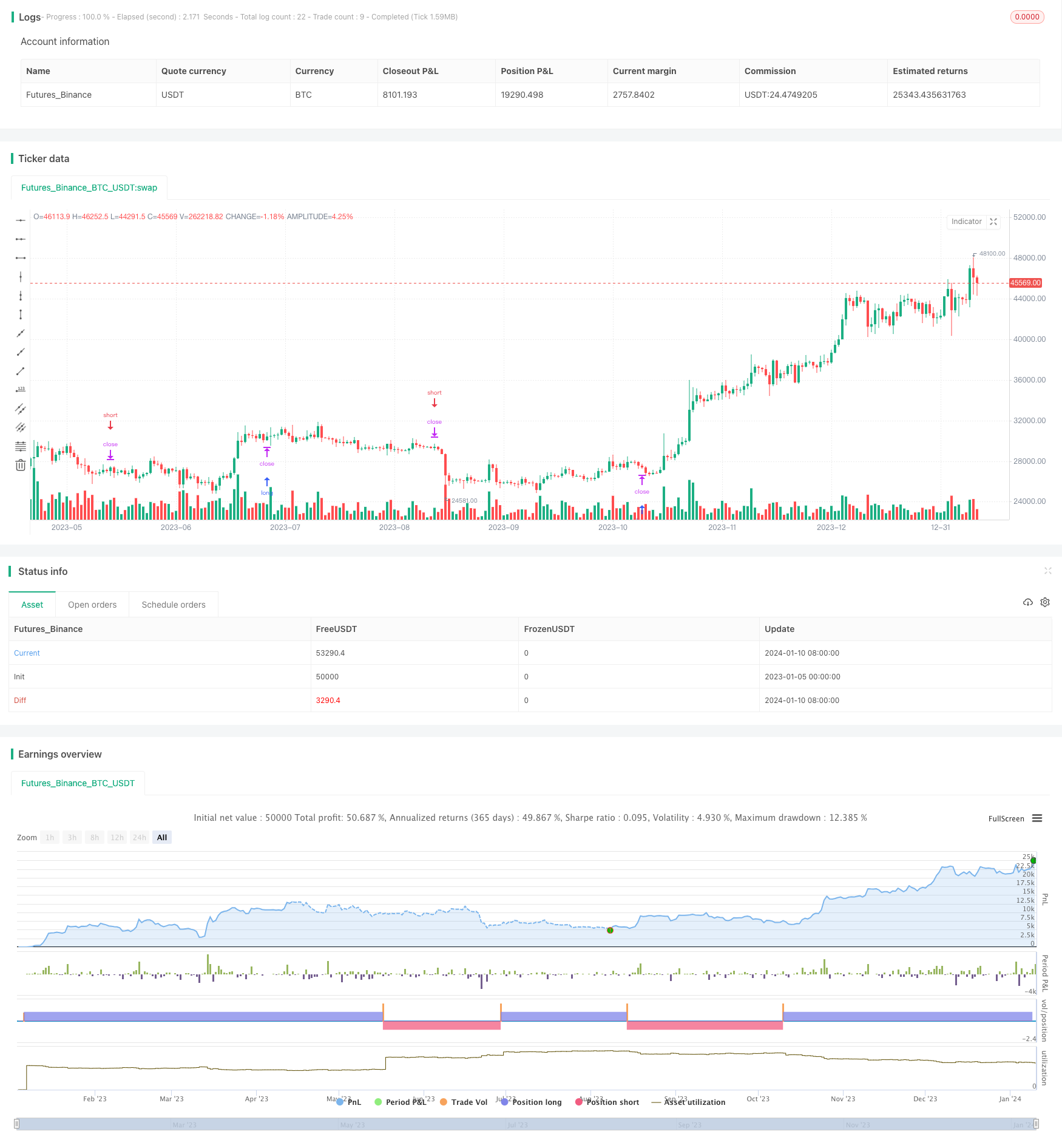
概述
比特币哈希带策略利用比特币网络的哈希率指标,当矿工衰竭结束、开始恢复时做多,当矿工开始衰竭时做空,通过捕捉矿工循环的波动来获利。
策略原理
该策略使用IntoTheBlock数据在交易视图中显示比特币每日哈希率。它计算快速移动平均线和慢速移动平均线,当快速移动平均线上穿慢速移动平均线时做多,认为矿工衰竭结束、开始恢复;当快速移动平均线下穿慢速移动平均线时做空,认为矿工开始衰竭。
具体来说,策略定义了两条移动平均线:SignalLine(默认长度30日)和LongLine(默认长度60日)。当SignalLine上穿LongLine时,认为是做多信号;当SignalLine下穿LongLine时,认为是做空信号。根据方向参数,策略会在出现对应信号时开仓做多或做空。
优势分析
该策略最大的优势是利用了比特币网络本身的特征,通过哈希率反映出矿工的扩张和收缩周期,形成交易信号。这避免了对 比特币价格本身复杂的分析,使用网络数据作为预测指标,相对简单可靠。
另一个优势是参数较少。主要就是快速平均线和慢速平均线的长度设置,非常简单,不会过度优化。同时,移动平均线算法也提供了多种选择,可以灵活调整。
风险分析
该策略主要风险在于哈希率数据提供商的质量。如果数据存在质量问题,会严重影响信号的准确性。目前IntoTheBlock提供的数据质量较好,但也需要注意其服务的持续性。
另一个风险是市场本身的系统性风险。即使捕捉到了矿工扩张和收缩的特征,在市场整体大幅波动时,仍可能遭遇亏损。需要关注更多市场指标判断系统性风险。
优化方向
可以考虑与价格指标结合,当价格指标也显示反转信号时,增加开仓确信度。例如结合K线形态指标、移动平均线指标等,当两者同时提示做多或做空时,再开仓。
可以测试不同周期的哈希带指标构建策略。例如使用周线或月线指标,过滤掉过多噪音,判断更大级别的趋势反转。
可以尝试机器学习模型判断哈希率反转的关键点。相比固定参数移动平均线,机器学习模型可能更好地模拟出反转的复杂特征。
总结
本策略整体思路清晰、简单,通过比特币网络本身的数据反映矿工周期,形成交易信号,避免复杂的价格预测,有一定的可靠性。但仍需要进一步优化与组合,降低市场系统性风险的影响,提高稳定盈利能力。
/*backtest
start: 2023-01-05 00:00:00
end: 2024-01-11 00:00:00
period: 1d
basePeriod: 1h
exchanges: [{"eid":"Futures_Binance","currency":"BTC_USDT"}]
*/
// This source code is subject to the terms of the Mozilla Public License 2.0 at https://mozilla.org/MPL/2.0/
// © Powerscooter
// Since IntoTheBlock only provides daily hashrate data, this chart might look chunky on lower timeframes, even with smoothing.
//@version=5
strategy("BTC Hashrate ribbons", overlay = true)
enableDirection = input(0, title="Both(0), Long(1), Short(-1)", group="Direction")
smoothingS = input.string(title="Smoothing short MA", defval="SMA", options=["SMA", "RMA", "EMA", "WMA"], group="Hashrate Settings")
SmoothLengthS = input(30, 'Short MA length', group="Hashrate Settings")
smoothingL = input.string(title="Smoothing long MA", defval="SMA", options=["SMA", "RMA", "EMA", "WMA"], group="Hashrate Settings")
SmoothLengthL = input(60, 'Long MA length', group="Hashrate Settings")
ma_functionS(source, length) =>
switch smoothingS
"RMA" => ta.rma(source, length)
"SMA" => ta.sma(source, length)
"EMA" => ta.ema(source, length)
=> ta.wma(source, length)
ma_functionL(source, length) =>
switch smoothingL
"RMA" => ta.rma(source, length)
"SMA" => ta.sma(source, length)
"EMA" => ta.ema(source, length)
=> ta.wma(source, length)
HashRate = request.security("INTOTHEBLOCK:BTC_HASHRATE", "D", close)
SignalLine = ma_functionS(HashRate, SmoothLengthS)
LongLine = ma_functionL(HashRate, SmoothLengthL)
plot(ma_functionS(HashRate, SmoothLengthS), "Short MA", color=color.yellow)
plot(ma_functionL(HashRate, SmoothLengthL), "Long MA", color=color.blue)
LongCondition = ta.crossover(SignalLine, LongLine)
ShortCondition = ta.crossunder(SignalLine, LongLine)
//Long Entry Condition
if LongCondition and (enableDirection == 1 or enableDirection == 0)
strategy.entry("Long", strategy.long)
if LongCondition and (enableDirection == -1)
strategy.close("Short")
//Short Entry condition
if ShortCondition and (enableDirection == -1 or enableDirection == 0)
strategy.entry("Short", strategy.short)
if ShortCondition and (enableDirection == 1)
strategy.close("Long")